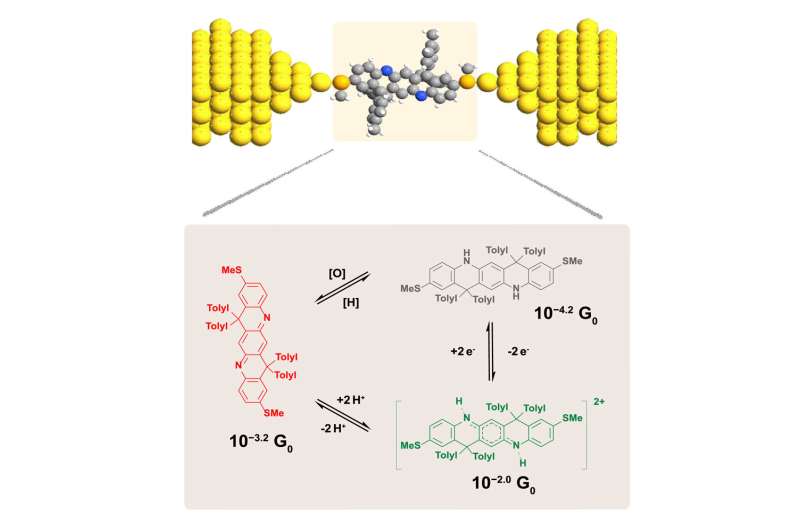Researchers demonstrate single-molecule electronic ‘switch’ using ladder-like molecules

Researchers have demonstrated a new material for single-molecule electronic switches, which can effectively vary current at the nanoscale in response to external stimuli. The material for this molecular switch has a unique structure created by locking a linear molecular backbone into a ladder-type structure. A new study finds that the ladder-type molecular structure greatly enhances the stability of the material, making it highly promising for use in single-molecule electronics applications.
Reported in the journal Chem, the study shows that the ladder-type molecule serves as a robust and reversible molecular switch over a wide range of conductivity levels and different molecular states.
“Our work provides a significant step forward towards the development of functional molecular electronic devices,” says Charles Schroeder, who is the James Economy Professor of Materials Science and Engineering and Professor of Chemical and Biomolecular Engineering at the University of Illinois Urbana-Champaign.
To enhance the chemical and mechanical stability of the molecule, the team used new strategies in chemical synthesis to lock the molecular backbone to prevent the molecule from rotating, like converting a rope ladder into something more stable like metal or wood.
“Imagine a light switch that we turn on and off every day, but instead of flipping an actual switch, we add chemical or electrochemical stimuli to turn the electrical signal from the material on and off,” says lead author and former graduate student Jialing (Caroline) Li. Compared to bulk inorganic materials, organic single molecules can be made into basic electrical components, like wires and transistors, and will help enable the ultimate goal of shrinking electrical circuits.
Single-molecule electronic devices are constructed as junctions with a single molecule bridge that is generally anchored to two terminal groups connected to metal electrodes. These devices can be made programmable by using a stimuli-responsive element in the bridge that can be switched on and off by using an array of stimuli such as pH, optical fields, electric fields, magnetic fields, mechanical forces and electrochemical control.
“The molecular scale switch has been a very popular subject in studies of single molecule electronics,” Li explains. “But realizing a multi-state switch on a molecular scale is challenging because we require a material that is conductive and has several different molecular charge states, and we require the material to be very stable so it can be switched on and off for many cycles.”
Though Li explored many other organic materials, the drawback of those materials was that they were not stable in ambient conditions and could break down easily when exposed to oxygen. After searching for the ideal material for a long time, Li struck gold when she stumbled upon a material from a research group at Texas A&M University (collaborators on this project) and immediately identified it as ideal for her purposes.
Modifying the structure by locking the backbone of the molecule prevents hydrolysis, chemical breakdown due to reaction with water, and other degradation reactions from occurring, and makes characterization of the material easier since it cannot rotate and change forms.
This rigid, coplanar form enhances the electronic properties of the molecule, making the flow of electrons through the material easier. The ladder-type structure allows for stable molecular charge states when external stimuli are applied that give rise to significantly different levels of conductivity—making multi-state switching possible.
This material meets almost all of the requirements needed to serve in single-molecule electronic devices: it is stable in ambient conditions, can be cycled on/off many times, is conductive (although not as conductive as metal) and has different molecular states accessible to be utilized.
“Researchers have been struggling to minimize the size of the transistor to fit as many as possible on chips for semiconductors, usually using inorganic materials like silicon,” Li says. “An alternative way of doing that is using organic materials like a single-molecule material to conduct the electrons and replace the inorganic counterparts.” The ladder-type structure used in this research shows promise to be used as functional materials for single-molecule transistors.
For now, only one unit of the molecule is used for single-molecule electronics, but it is possible to extend the length to include many repeating units to make a longer molecular wire. The team believes that the material will still be highly conductive, even over a longer distance.
More information:
Jialing Li et al, Ladder-type conjugated molecules as robust multi-state single-molecule switches, Chem (2023). DOI: 10.1016/j.chempr.2023.05.001
Citation:
Researchers demonstrate single-molecule electronic ‘switch’ using ladder-like molecules (2023, June 30)
retrieved 30 June 2023
from https://phys.org/news/2023-06-single-molecule-electronic-ladder-like-molecules.html
This document is subject to copyright. Apart from any fair dealing for the purpose of private study or research, no
part may be reproduced without the written permission. The content is provided for information purposes only.
For all the latest Science News Click Here
For the latest news and updates, follow us on Google News.

